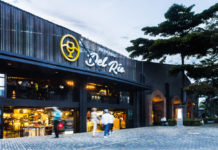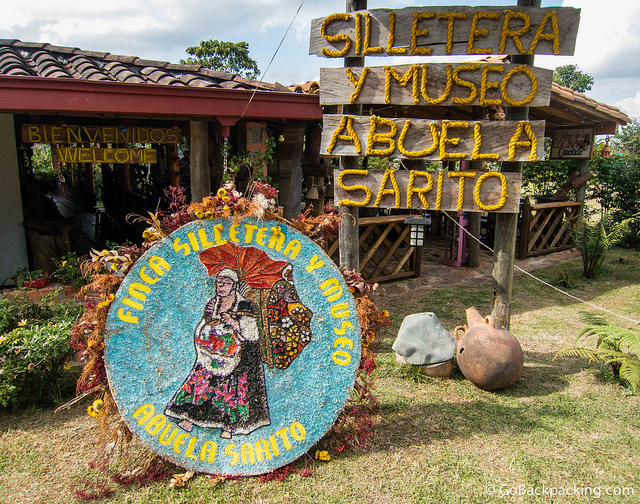
Santa Elena, more than anything else, is known as the birthplace of the men, women, and tradition behind the Desfile de las Flores (Flower Parade), the highlight of Medellin’s annual Feria de las Flores (Flower Festival).
The heroes of this parade, the hundreds of paisas of all ages, both male and female, carrying elaborate floral displays, are called silleteros.
During my recent weekend in Santa Elena, I, along with several other bloggers from Colombia and Spain, had the chance to learn about the culture of the silleteros, as well as the history of the Flower Parade (which later evolved into the much bigger festival we know today).
Finca Silletera y Museo Abuela Sarito
After spending the morning exploring Parque Arvi, we headed to Finca Silletera y Museo Abuela Sarito.
The finca was once the home of Don Vasquez’s grandmother, and has since been turned into a museum.
[Note: Out of respect, the older silleteros are addressed with “Don” followed by their last name.]

The attendees were a who’s who of silleteros, many of whom devoted their lives to keeping the tradition of their parents alive through the generations.
Don Aristides, for example, has been a silletero for over 40 years!
Each silletero and silletera is the embodiment of Antioquian culture. It was an honor to meet them.

Introductions were made under a tent, where we offered small cups of warm herbal tea.
As we rolled toward late afternoon, the sun disappeared, and grey clouds began to cover the sky.
Temperatures dropped, and a brisk wind added to the chill in the air.
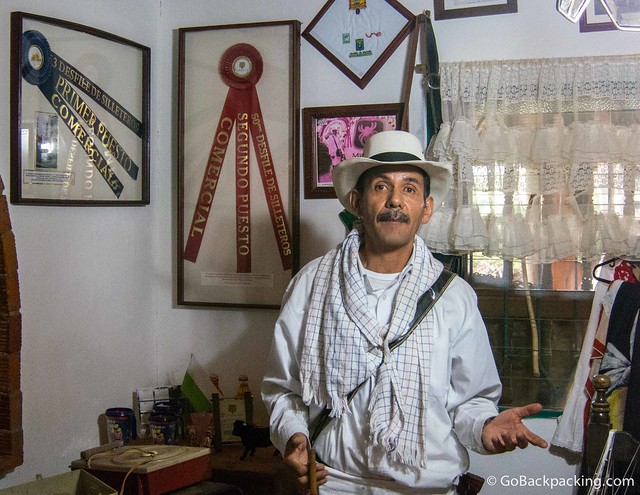
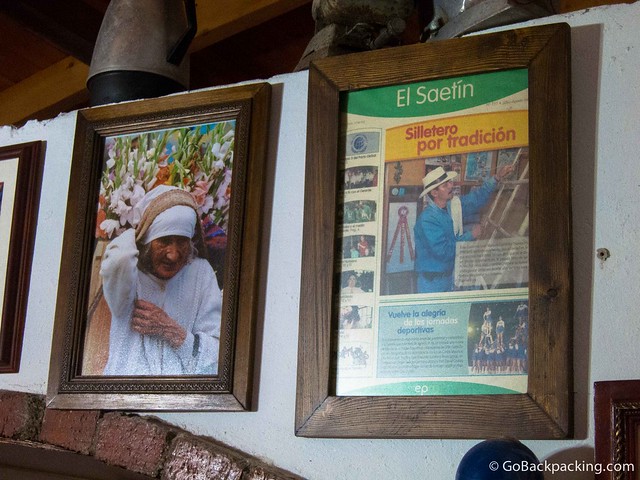
Don Vasquez then gave us a tour of his museum.
Strewn along the wrap-around porch was a curious collection of items, from antique kitchen equipment to old stereos and TV’s.
The house/museum’s interior was filled with more stuff, including souvenirs (for sale, I believe) to non-functioning old guns and rifles, and even an old VHS camcorder he showed us.
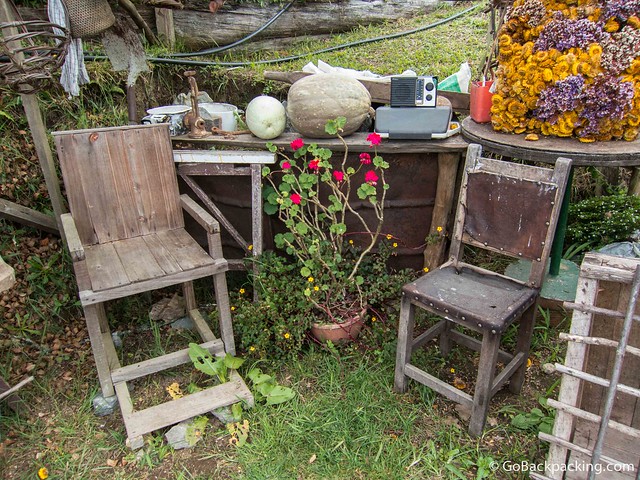
Origins of the Silleteros and Flower Parade
As far back as 200 years, during Colonial times, the sick were carried down from Santa Elena to Medellin in crude wooden seats, on the backs of silleteros.
If that weren’t challenge enough, the silleteros walked barefoot a minimum of 3 hours each way to deliver their passengers.
Later, the seats were adapted for carrying other items, such as vegetables and flowers, which the silleteros would take to sell in the markets.
In the mid-1950’s, someone noticed the parades of beautiful flowers being hauled through the streets of Medellin, and suggested an event be made to celebrate them.
With that observation, the Flower Parade was born.
I’ve long known being a silletero is an honor to the men and women from Santa Elena. What I didn’t realize was that it is a tradition and livelihood passed down from parents to their children.
Becoming a silletero isn’t as easy as throwing some flowers together, and walking in the parade.
There are regulations governing who can carry the silletas (flower displays), and if you aren’t born into it, I believe you need to find a silletero willing to transfer the role.
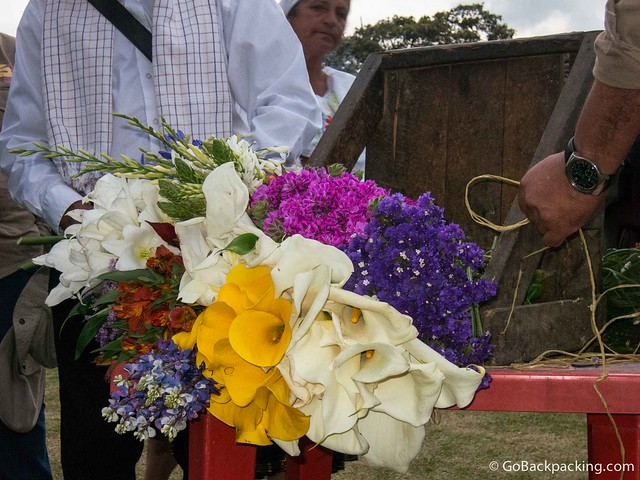
After our tour of the finca and museum, the silleteros began to demonstrate how they put together a silleta.
Layers of different flowers are placed on top of each other, the stems chopped off at varying lengths.
Twine is then used to hold the flowers in place, until the whole thing is filled.
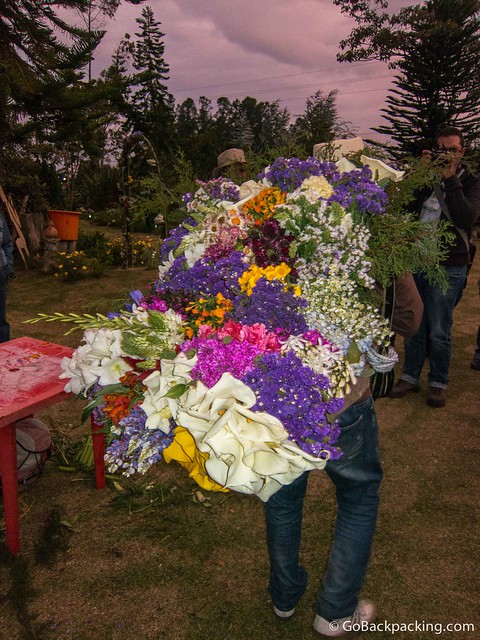

Once the silleta was complete, I loaded it on my back.
From the photo above, it may not look very big, and you might not think of flowers as being heavy, but the silleta weighed a ton!
I could barely turn in a circle, let alone imagine walking barefoot from Santa Elena to Medellin, or walking the 10 kilometers required in the Flower Parade.
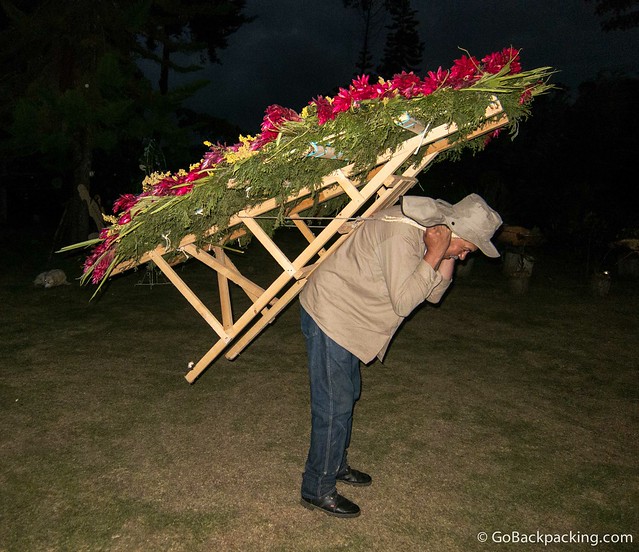
Silletas come in 4 categories:
- Commercial (advertisements)
- Emblematic (such as cultural symbols)
- Monumental (the biggest)
- Traditional (like what I was carrying above)
After I took a shot at carrying the traditional silleta, one of the silleteros showed us how to carry the large, round displays.
The technique of using your forehead was similar to what I’d seen sherpas and other Nepalese people doing in the Annapurna region.
I took a pass on trying the second, larger silleta, though I was informed it wasn’t necessarily that much heavier than the one I tried.
By dark, it was not just cool, but cold. We said our goodbyes, and split up to have dinner in different restaurants, before retiring for the night.
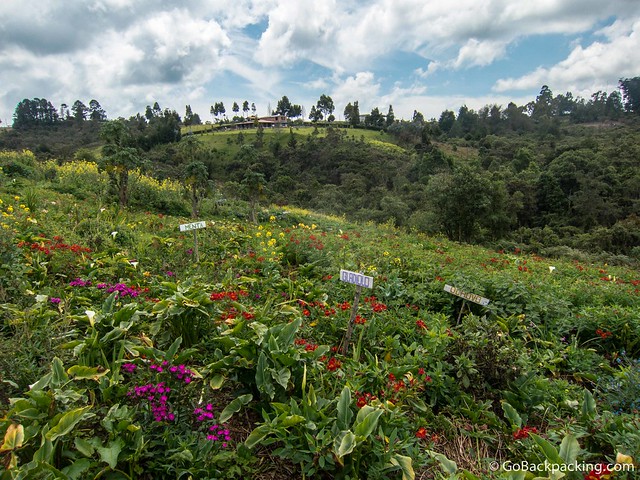
Q&A with Don Joaquin
The next morning, after another peaceful breakfast at La Montana Magica, Viviana, Gus (translator), and I headed to Finca Silletera Los Girasoles to meet Don Joaquin, another silletero.
There, he gave us a tour of his flower garden, and shared with us some of his photo albums.
Don Joaquin has been carrying silletas in the Flower Parade for 31 years, and before that, he was attending as a kid while his father carried them.
He’s won 5 awards, and says those years are his favorites.
He learned from his father, just as his four kids are learning from him. A few of them have already won awards as well, so clearly the skill runs in the family.
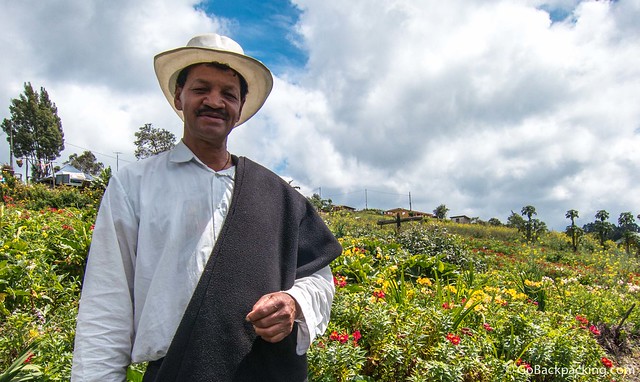
It was easier to sit and chat with Don Joaquin one on one (via Gus), versus the previous day when there were a few dozen of us mixing together.
Don Joaquin had won an award for best monumental silleta in 2012. It was on display near the door of his house, the flowers now dry and faded. He said it weighed 120 kg (250 lbs).
Did he ever feel like stopping, and giving up, while carrying such large displays in the parades?
No. Rain or shine, the thought never occurred to him because of all the cheering people lining the parade route.
How much could he make from a single silleta?
He said a company might pay 23 million pesos ($12,600) to commission one of the largest silletas.
The silletero would get just 2 million pesos ($1,100) to create the silleta, and the rest would go to the government.
If a silleta wins, there might be a bonus of another 2 million pesos ($1,100).
While that might not seem like a lot, the Colombian government pays for the winning silleteros to travel both domestically within Colombia, as well as internationally.
More importantly, Don Joaquin said, the silleteros do their work for the love of it, not the money.
That said, the Flower Parade only happens once a year, so Don Joaquin supplements his income by selling organic vegetables, as well as drinks and food to visiting tour groups.
_________
My visit to Santa Elena was at the invitation of Paso Bueno to promote tourism in the region.




